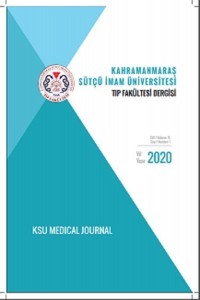İnvajinasyonda Tedavi Yaklaşımı: Takip mi, Cerrahi mi?
İnvajinasyon, takip, ultrasonografi, uzunluk.
Management of Intussusception: Follow-up or Reduction?
Intussusception, follow-up, ultrasonography, length,
___
- Jiang J, Jiang B, Parashar U, Nguyen T, Bines J, Patel MM. Childhood intussusception: a literature review. PLoS One . 2013;22;8(7):e68482.
- Justice FA, Auldist AW, Bines JE. Intussusception: trends in clinical presentation and management J Gastroenterol Hepatol . 2006;21(5):842-6.
- Zhang Y, Bai YZ, Li SX, Liu SJ, Ren WD, Zheng LQ. Sonographic findings predictive of the need for surgical management in pediatric patients with small bowel intussusceptions. Langenbecks Arch Surg 2011;396(7):1035–40.
- Munden MM, Bruzzi JF, Coley BD, Munden RF. Sonography of pediatric small-bowel intussusception: differentiating surgical from nonsurgical cases. AJR Am J Roentgenol 2007;188(1):275–9.
- Ko SF, Lee TY, Ng SH, et al. Small bowel intussusception in symptomatic pediatric patients: experiences with 19 surgically proven cases. World J Surg. 2002;26(4): 438-43.
- Koh EP, Chua JH, Chui CH, Jacobsen AS. A report of 6 children with small bowel intussusception that required surgical intervention. J Pediatr Surg. 2006;41(4):817-20.
- Doi O, Aoyama K, Hutson JM. Twenty-one cases of small bowel intussusception: the pathophysiology of idiopathic intussusception and the concept of benign small bowel intussusception. Pediatr Surg Int. 2004;20(2):140-3.
- Siaplaouras J, Moritz JD, Gortner L, Alzen G. Small bowel intussusception in childhood. Klin Padiatr. 2003;215(2):53-6.
- Arslan S, Turan C, Doganay S, et al. The effectiveness of pneumoreduction for intussusception. Ann Ital Chir. 2014;85(5):459-63
- Strouse PJ, DiPietro MA, Saez F. Transient small-bowel intussusception in children on CT. Pediatr Radiol. 2003;33(5):316-20.
- Cohen MD, Baker M, Grosfeld JL, Siddiqui A. Post-operative intussusception in children with neuroblastoma. Br J Radiol. 1982;55(651):197-200.
- Ko SF, Tiao MM, Hsieh CS, et al. Pediatric small bowel intussusception disease: feasibility of screening for surgery with early computed tomographic evaluation. Surgery.2010;147(4):521-8.
- Ein SH. Recurrent intussusception in children. J Pediatr Surg 1975;10(5):751-5.
- Turner D, Rickwood AM, Brereton RJ. Intussusception in older children. Arch Dis Child. 1980;55:544-6
- Xiaolong X, Yang W, Qi W, Yiyang Z, Bo X. Risk factors for failure of hydrostatic reduction of intussusception in pediatric patients: A retrospective study. Medicine (Baltimore). 2019;98(1):e13826
- Ekinci RMK, Balci S, Melek E et al. Clinical manifestations and outcomes of 420 children with Henoch Schönlein Purpura from a single referral center from Turkey: A three-year experience. Mod Rheumatol. 2020;30(6):1039-46.
- Güney LH, Fakıoğlu, E, Acer T, Ötgün I, Arslan EE, Akıllı MS, et al.Is every intussusception treatment an emergency intervention or surgery? Ulus Travma Acil Cerrahi Derg, March 2016;22:139-144.
- Vandewalle RJ , Bagwell AK, Shields JR et al. Radiographic and Clinical Factors in Pediatric Patients With Surgical Small-bowel Intussusception. J Surg Res. 2019;233:167-172
- Lvoff N, Breiman RS, Coakley FV, Lu Y, Warren RS. Distinguishing features of self-limiting adult small-bowel intussusception identified at CT. Radiology 2003;227:68–72.
- ISSN: 1303-6610
- Yayın Aralığı: Yılda 3 Sayı
- Başlangıç: 2004
- Yayıncı: Kahramanmaraş Sütçü İmam Üniversitesi
Seher KARAHAN, Ezgi AĞADAYI, Mehmet Mert KOÇ, Bilgehan YAVUZ, Zeynep İrem YILDIZ, Ilgın ECE, Selin KARAPINAR, Melih ÖZELLİ
Özge ÖZDEMİR, Can ACIPAYAM, Murat ARAL, Sedef TERZİOĞLU ÖZTÜRK
Gamze ERTAŞ, Hamiyet ŞENOL ÇAKMAK, Sevda AKDENİZ, Ebru POLAT, İlker Hasan KARAL, Serkan TULGAR
Çocuk Kraniyal Travma Hastalarında Radyasyon Maruziyetinin Değerlendirilmesi
Kamil DOĞAN, Adil DOĞAN, Seda Nida KARAKÜÇÜK, Hakan HAKKOYMAZ, Şükrü GÜNGÖR
SARS-CoV-2 Hangi Dokularda Patolojiye Neden Oluyor?
Parkinson Hastalarında Nöropsikiyatrik Semptomlar
Tuğba KAYA, Buket TUĞAN YILDIZ
Tıp Fakültesi Anatomi Anabilim Dalı Yüksek Lisans Tez Konularının Değerlendirilmesi
Mehmet DEMİR, Sibel ATEŞOĞLU KARABAŞ, Fatma Beyzanur SUBAŞI, Atila YOLDAŞ
Ocrelizumab Kullanan Multipl Skleroz Hastalarında Hepatit B Virüsü Serolojisi
Özlem GÜLER, Buket TUĞAN YILDIZ, Hakan HAKKOYMAZ, Süleyman AYDIN, Meltem YARDIM
